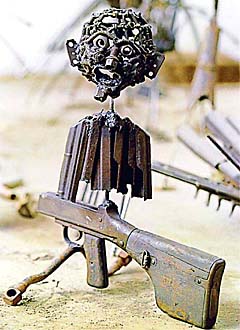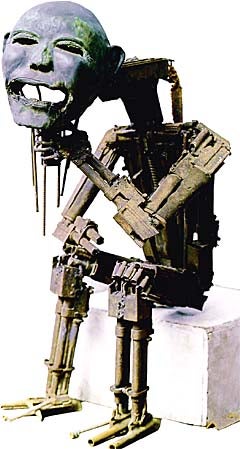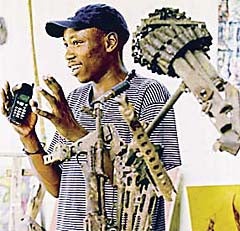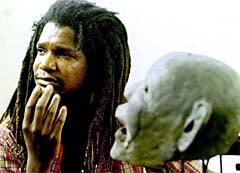December 29, 1999
ARTS ABROAD
Swords Into Whimsy Instead of Plowshares
Related Article
Museum and Show Information From New York Today
Forum
Join a Discussion on Artists and Exhibitions
By RACHEL L. SWARNS
 APUTO, Mozambique -- Push through the black iron gate, slip into
the tiny garden and there, amid crab grass, wild flowers and snake
plants, lies the detritus of this country's savage civil war.
Only now rusting AK-47's have been fashioned into a baby's cradle.
Empty machine guns curve into a globe, frozen on its axis. A rifle's
snout becomes the spinal cord of a half-made human being. The
aging weapons in this open-air studio, disabled now, were the
ones that killed and maimed during the 16-year-war that raged
until 1992 and took more than a million lives.
APUTO, Mozambique -- Push through the black iron gate, slip into
the tiny garden and there, amid crab grass, wild flowers and snake
plants, lies the detritus of this country's savage civil war.
Only now rusting AK-47's have been fashioned into a baby's cradle.
Empty machine guns curve into a globe, frozen on its axis. A rifle's
snout becomes the spinal cord of a half-made human being. The
aging weapons in this open-air studio, disabled now, were the
ones that killed and maimed during the 16-year-war that raged
until 1992 and took more than a million lives.
|



 Photographs by Joao Silva/ Sygma, for The New York Times Photographs by Joao Silva/ Sygma, for The New York Times
|
Top photos, two works by Fiel dos Santos, a member of the Núcleo
de Arte workshop in Maputo, Mozambique, where artists are creating
sculptures from rifles, machine guns and other deadly weapons
that devastated their country during the 16-year civil war that
raged until 1992. Third photo, Goncalo Armando Mabunda, another
member of the workshop, with his "Saxophone Player." Fiel dos
Santos with one of his sculptures at the workshop, below.
|
The sculptor Fiel dos Santos runs his fingers over the silent
rifles and deactivated grenades and remembers the machine gun
blasts that shook his neighborhood and his childhood. But then
he pulls on his goggles and fires his welding machine, and the
guns buckle, change, transform.
"There are times when I start thinking, 'This killed, this killed,
this killed,' and then the weapons are difficult to touch," said
Mr. dos Santos, 27. "But by creating this art, I'm destroying
these weapons," he added. "I'm creating something new, something
that will make people think differently of the war."
Seven years after the fighting ended, young artists here in the
capital are turning weapons of destruction into sculpture that
celebrates everyday life in Mozambique's postwar society. Using
machine guns, rocket launchers and land mines given up by former
combatants, the artists are creating whimsical images and transforming
the deadly instruments that devastated their country.
The arms-into-arts project began two years ago when the Christian
Council of Mozambique was deciding what to do with the thousands
of weapons it was collecting from former soldiers and rebels,
and approached the members of Núcleo de Arte, a well known artists'
studio, workshop and meeting place here.
The artists were young men who grew up listening to the daily
war bulletins on their radios. They heard the gunfire ringing
outside their windows. They lost relatives to kidnappings and
killings. And they often went hungry because the food shortages
meant there was never enough rice or flour or meat.
The council, which has so far collected 72,000 weapons from former
combatants, sees the ongoing project as a way to help Mozambicans
come to terms with the years of violence and to show the world
the progress since the war's end.
"We don't want to forget about the war," said Christian Brun,
the art project adviser for the council. "People have to remember
what it was and see how it can be transformed, to give people
hope and to confirm the new phase of peace and rebuilding."
The sculptures are currently on display in a new online exhibition
(www.africaserver.nl/nucleo/eng/ index.html), and the artists say the show is yet another symbol of Mozambique's
remarkable recovery.
The building boom and the surge in foreign investment that have
made this country one of Africa's success stories in recent years
have also been accompanied by the stirrings of an artistic revival.
In 1993 young artists reopened the Núcleo de Arte, which was closed
during the civil war. In 1997 the Durban Art Gallery in South
Africa presented 32 works by Núcleo artists, the first large exhibition
of Mozambican art to be displayed in that country. Now the weapon
sculptures are being exhibited across Europe.
Mozambique is still one of the poorest countries in the world,
and for most people an artist's life is still an unimaginable
luxury. But a combination of increasing foreign and government
support coupled with a general improvement in the standard of
living here has given young artists a sense of optimism, a change
that is reflected in their work.
In the online exhibition, for instance, there is a sprightly bird
with a bayonet for a beak. A young mother with a rifle handle
for a skirt. A dancer who leaps on machine-gun-barrel legs.
Gonçalo Armando Mabunda, who once created a motorcyclist covered
in land mines, depicting a man who does not know he is about to
explode, is now working on a saxophone player with a rocket launcher
for a horn. The piece was inspired, he said, by a musician friend
who plays at a crowded club on Friday nights.
During the war young people had few places to dance and listen
to music, Mr. Mabunda said. But today the jazz clubs are packed
with people.
"The sad piece was because there was still this sense of war,"
said Mr. Mabunda, 24, of the motorcycle sculpture. "But as time
goes by, I feel a new spirit. And the work changes as those feelings
change."
The weapons arrive in the studio here in wooden boxes, already
disabled and disarmed. The artists pick through the rusting bits
and pieces, envisioning a leg in a machine gun barrel, some hair
in a bunch of bandoliers.
They are a varied lot who work in oils, wood, soapstone and papier-mâché.
But not one was untouched by the back-and-forth fighting between
Frelimo, the dominant party in the current government, and Renamo,
the rebel movement that opposed it.
Mr. Mabunda's favorite cousin, Gabriel, a government soldier,
was killed when his truck rolled over a land mine. Mr. dos Santos's
brother, Manuel, was kidnapped by the rebels and forced to fight
against the government for six years.
Of Mozambique's roughly 15 million people at the time, it is estimated
that up to one million died, 1.5 million fled to refugee camps
in neighboring countries and perhaps 3 million more were driven
from their villages into overcrowded towns and cities.
During the war many of the young artists had to scrounge for paint
and paper, and some used charcoal from cooking fires to scribble
on the streets and walls.
They did not have opportunities to expose their works because
everyone was absorbed by the war, said João Paulo Queha, 25, who
has used the guns to create a sculpture of his mother gathering
firewood.
"People have more room in their lives to think about art now,"
Mr. Queha said. "You can see even though they have no possibilities
of acquiring art, they have the feeling for art, the appreciation
of art."
Life is not easy, of course. The artists make little money, and
many rely on friends and family to get by. But here in the art
studio the artists revel in their newfound freedom.
And on hot afternoons the guitars are strummed and harmonicas
whine as the young men sing and work, free from the anxieties
of a country at war.
"I love music, but I have a terrible voice," Mr. Mabunda said
as he displayed his unfinished sculpture of the saxophone player.
"This is my way of singing, of making music."
![]()
![]()
![]()

 APUTO, Mozambique -- Push through the black iron gate, slip into
the tiny garden and there, amid crab grass, wild flowers and snake
plants, lies the detritus of this country's savage civil war.
Only now rusting AK-47's have been fashioned into a baby's cradle.
Empty machine guns curve into a globe, frozen on its axis. A rifle's
snout becomes the spinal cord of a half-made human being. The
aging weapons in this open-air studio, disabled now, were the
ones that killed and maimed during the 16-year-war that raged
until 1992 and took more than a million lives.
APUTO, Mozambique -- Push through the black iron gate, slip into
the tiny garden and there, amid crab grass, wild flowers and snake
plants, lies the detritus of this country's savage civil war.
Only now rusting AK-47's have been fashioned into a baby's cradle.
Empty machine guns curve into a globe, frozen on its axis. A rifle's
snout becomes the spinal cord of a half-made human being. The
aging weapons in this open-air studio, disabled now, were the
ones that killed and maimed during the 16-year-war that raged
until 1992 and took more than a million lives.



 Photographs by Joao Silva/ Sygma, for The New York Times
Photographs by Joao Silva/ Sygma, for The New York Times ![]()